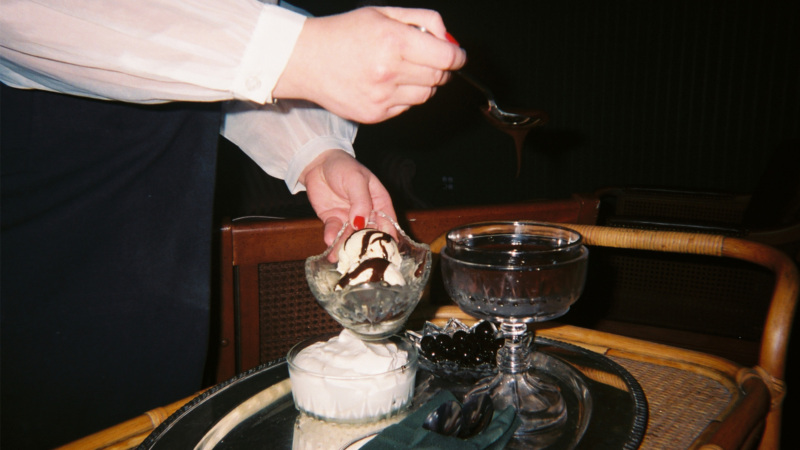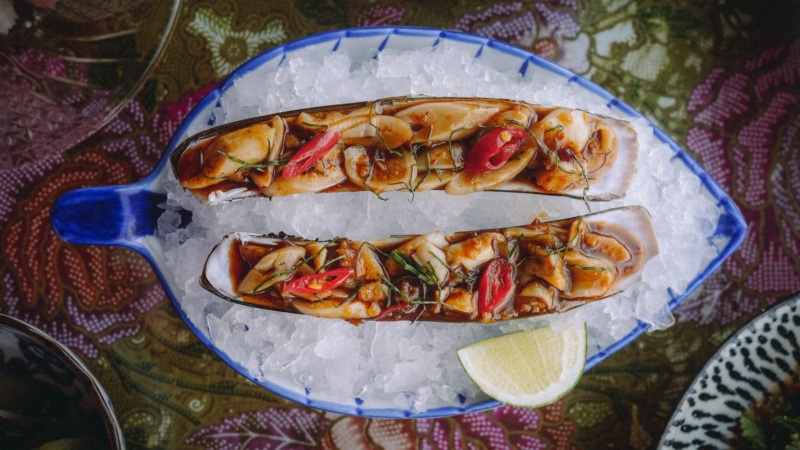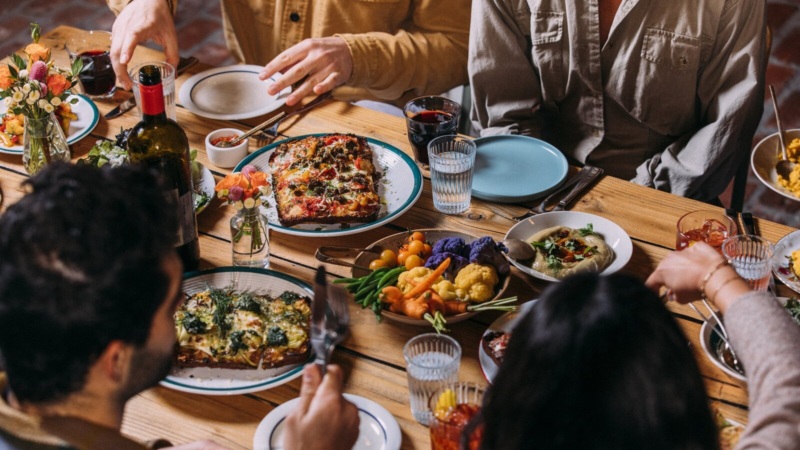
David Tanis on Building Lulu, and Making a New Debut in L.A.
When the doyenne of seasonal California cooking calls on you to open a new restaurant in a new city, any chef worth their fleur de sel would probably say yes. David Tanis did when his mentor and former boss asked if he would head up Lulu at the Hammer Museum in Westwood.
Tanis, who had been living in New York until moving to Los Angeles this past summer, thought it sounded like just the thing he needed at this time in his life — even during a pandemic.
“I said yes, that sounds nice. But it was a lot of talking for many, many, many months,” Tanis says. ”It has been such a wacky two years, and the future’s so uncertain. But we’re lucky to have the outdoor space, and it’s nice to be able to open.”
Tanis, of course, worked with Waters for almost three decades, starting as a bread baker at Chez Panisse in 1981 and retiring as co-head chef in 2011. There were gaps, like when he opened a restaurant in Santa Fe, New Mexico; later, he spent six months a year in Paris, splitting chef duties with Jean-Pierre Moullé at Chez Panisse. In his time behind the stoves, he was instrumental in helping define the cooking style of the famed Berkeley restaurant.
Ten years ago, Tanis moved to New York to become a full-time writer, most notably to pen a monthly column on seasonal, market-to-table cooking for the New York Times. He’s written several cookbooks to date, including his latest, “David Tanis Market Cooking.” Knowing his farmers, extracting the best of what seasonal produce can be, creating simplicity on a plate, incorporating flavors from around the world, serving it in a relaxed, natural setting — Lulu is definitely in his wheelhouse.
But this is his first time back in a restaurant kitchen since leaving San Francisco, and Waters’ first restaurant outside Northern California. It’s also one of the most unstable times to open a high-profile concept, when most restaurateurs have been fighting for survival as a global pandemic rages on, all the while trying to fix social inequities and pay disparities within the industry, while also dealing with rising food, health, and business costs, and staff shortages.
Still, Tanis jumped at the chance. While Waters isn’t involved with the day-to-day running of the restaurant, she conceived the idea with Hammer director Ann Philbin. The two envisioned a unique gathering place for UCLA students, artists, farmers, friends, and anyone who would be excited to dine at a restaurant with Waters’ name attached. Having Tanis come out of restaurant retirement to cook feels like an extra bonus.
Audrey, the Hammer’s fairly new restaurant that closed in 2020, left great bones. The mostly outdoor space takes advantage of the wonderful light that brightens the courtyard, with trees and native plants interspersed around natural wood tables — they’re made from a 50-year-old bunya tree that fell a few blocks from the museum — including one down the middle filled with bowls of quince, pomegranate, heirloom apples, and whatever else is in season.

There’s a covered but open dining room and bar as well, making Lulu the perfect spot for an afternoon glass of wine in any kind of weather, along with an eggplant banh mi, baked goat cheese and greens, or a three-course lunch menu showcasing whatever it is Tanis was inspired by at the market that day.
Like a curated exhibit in one of the galleries, the hope is that Lulu will attract a new clientele to the museum on a regular basis — with an evolving menu, there’s always something new to try. Those who already make the Hammer a habit now have something to keep them there even longer.
While the restaurant continues to get off the ground (it’s still only serving lunch, with dinner starting sometime next year), Tanis found a few moments to speak with Resy about opening Lulu, what Los Angeles cuisine means to him, and how he hopes to create a more collaborative experience in his kitchen and beyond.
RESY: What compelled you to get back in the game, to take on the extra stress of running a restaurant again? Especially now. There’s a beauty to it, of course; it’s great work. But hard.
David Tanis: You mean what the hell was I thinking, do I ask myself that every other day? [Laughs] I’m having a lot of fun. During my time in New York I did spend a fair amount of time in kitchens even though I wasn’t running a restaurant. Whenever Alice would come to the East Coast, I’d do her special events.
Have you been to the Hammer Museum before? Has any of the art inspired you?
No, no. I’ve never lived in L.A. I have a lot of friends here, of course. And I’ve visited a number of times. But I never lived here. So it’s really a bit of culture shock to a certain extent. But I like to do something new every 10 years. Just being in the Hammer is inspiring.
And here you are back on the West Coast. Has anything really surprised you about Los Angeles so far?
I think I wasn’t really quite aware of the distances between places. Somehow I never grasped that aspect. So now, if I want to visit friends in Silver Lake, then I have to drive an hour to get there. So that’s been sort of an adjustment. But I have to tell you, in the few months that I’ve been here, I’ve mostly been at the restaurant. So I’m looking forward to getting out to do more exploring. I’ve visited a few farms and I do get to the farmers markets a few times a week, so that’s great.

Which markets do you frequent? What farms are you working with?
My most frequent ones are Santa Monica on Wednesdays and Hollywood on Sundays. But also Santa Monica on Saturdays. I would go to any market any day of the week, really. I know California produce, but when you’re living on the East Coast, and you visit the West Coast — even Portland or Seattle — the farmers markets are so abundant. It’s such a difference from the winter farmers markets in New York.
We get a few things from this one and things from that one. Peter Schaner [Schaner Farms]. Kenter Canyon, those are actually old friends of mine. Flora Bella. Weiser Farm. There are just so many good stands.
Has the L.A. crowd been responsive to the menu?
We have had really nice customers. We’ve had a lot of interest in the prix fixe menu.
That’s great to hear. It’s such a civilized thing to do in the middle of the day. It almost feels extravagant to have a leisurely lunch, but it’s something we could all use right now.
Yes. But it’s not fancy; it’s simply a curated menu. So it’s really designed for that day specifically. We have just as many fans for the bar menu, too. It balances out. And we’ve been busy, which is great but a little stressful.
Do you mostly let the market dictate the menu?
Absolutely. What is in the market is what is going to be served. That’s where the inspiration is. I find it really inspiring to go to the market, always have. It’s a really old-fashioned way of cooking, you go to the market, see what looks good, and you go home and cook it.

You also pull from your personal recipes, your cookbooks.
Oh yes. And many other cookbook authors that I admire. There’s inspiration in the air.
How will the menu evolve at LuLu? What will dinner be like?
I can’t tell you what the future holds. I don’t know what’s going to happen for dinner yet. We’re still sort of getting our toes wet.
You helped define California cuisine during your years at Chez Panisse. Are you amazed by how it has evolved, especially here in Los Angeles?
The essence of California cuisine revolves around produce. L.A. cuisine, in my opinion, has its own little niche under the topic of California cuisine. It will take me a little while being here to understand more about it, but yes, I really like the cultural diversity. The fact that you can get food from anywhere [around the world] just about everywhere.
The idea that California cuisine revolves around produce — that was rather groundbreaking at the time when Chez Panisse opened. Did you feel that when you worked there?
So many people take for granted that you can go to the market and find everything from arugula to pomegranates, but that wasn’t always the case. It always felt like very special work to me. It felt like being part of a movement. It still does, for that matter.
What do you mean?
I think it’s going to take activism on the part of chefs to get things the way they ought to be. The climate crisis is no joke. Farming practices and shopping practices can help. You know, the whole vote-with-your-fork idea.
You said in a recent LA Times article: “Chez Panisse proved there are other ways — more human ways, collaborative ways — to run a restaurant.” What does that mean to you? How does that fit in today’s world, especially post-pandemic, if we ever get there?
Oh, can we please get to post-pandemic! I think things are changing in lots of ways in kitchens. There has always been a hierarchical approach to restaurant work, and a lot of the conditions are not exactly humane. There’s a certain kind of caste system in the old style of restaurants. For me, it works better when the whole process is collaborative. There’s a lot of discussion among staff, how to do things, better ways to do things. And it’s not all coming from the top down. In a collaborative kitchen, there are ways to enjoy the work and enjoy the activity, the act of cooking.
You also said that you aren’t a chef-y chef, that you’re more of a home cook who happens to cook for the public. How does that translate to your menus?
It might be slightly more refined than a home kitchen, but it is mostly what I call good home cooking. I think simplicity is a hard sell in certain cases, but when people taste the food, they understand what that means.
Seemingly simple dishes turned extraordinary is truly the art of cuisine, isn’t it? It still takes talent to know what to use and how to use it.
I think it’s still an artistic expression. There is still a certain amount of theater here, but it’s a different kind of artistic expression.
It can be like theater, for sure. In the dining room, too, the way the staff moves, the grace of their actions, how they speak to guests. And that’s the ultimate goal at LuLu, or any restaurant, really. Just offering a great experience.
We almost forgot about what it’s like, right? But yes. I hope that we have a space that is really inviting, that it is somehow stimulating, and that it becomes a real community.
Lesley Balla writes about restaurants, travel, wine, and more. You’ll find her work in publications including Los Angeles magazine, Angeleno, The Hollywood Reporter, and The Seattle Times. In a previous life she was the L.A. editor for Zagat and Eater. Follow her on Twitter and Instagram. Follow Resy, too.
















